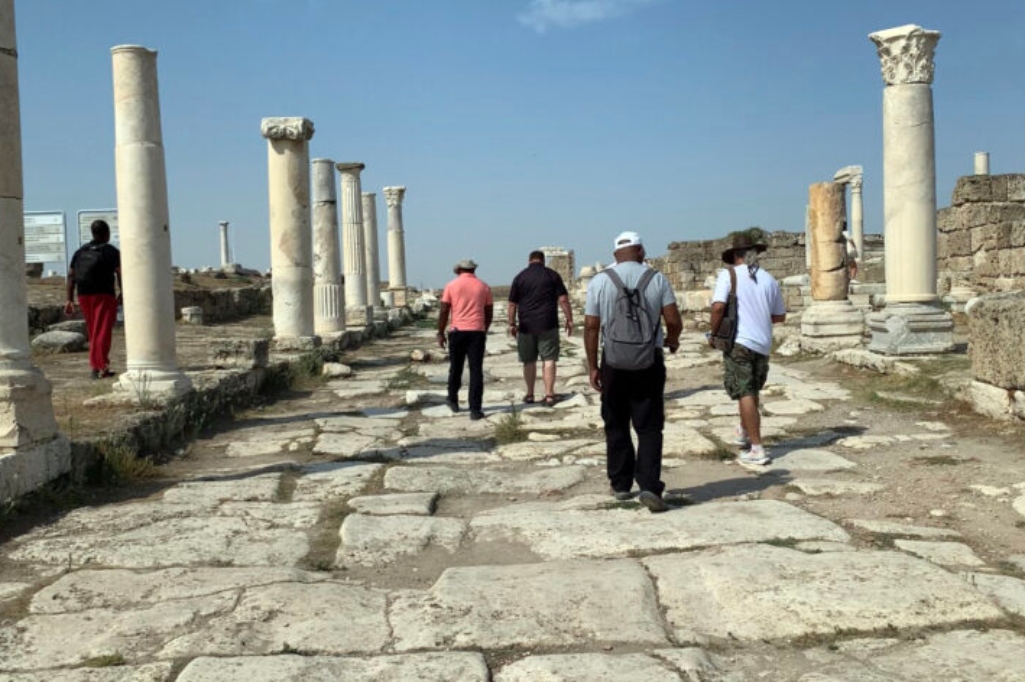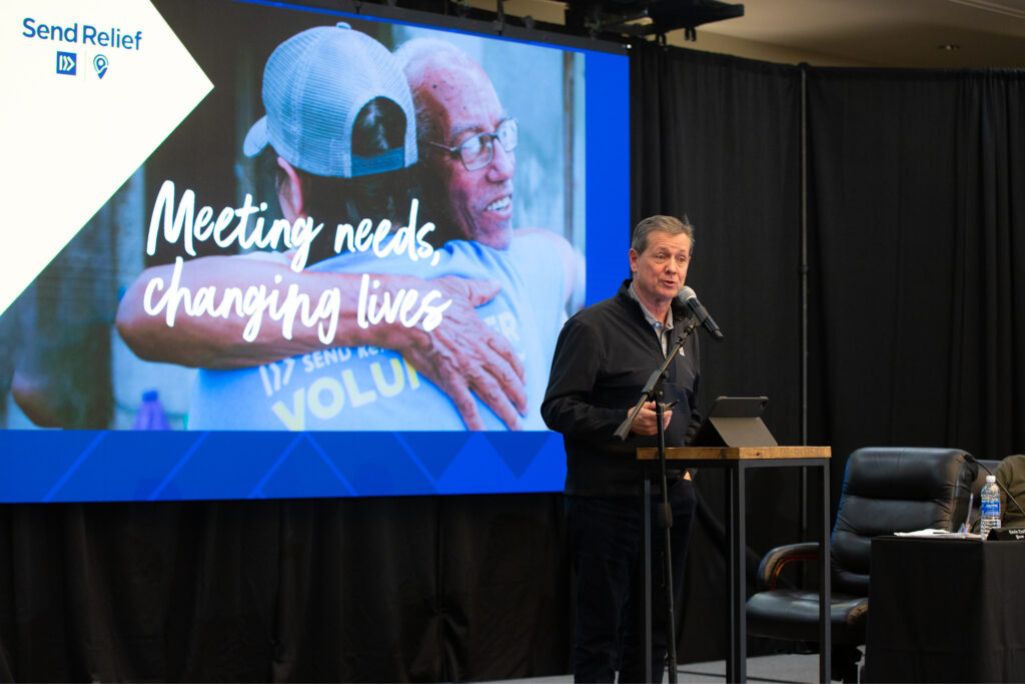
The day after Hurricane Debby made landfall in Florida, Southern Baptist Disaster Relief had set up in the parking lot of First Baptist Church Perry, Fla., to provide meals for the community.
EAST COAST — Debby’s not done, but Southern Baptists aren’t waiting.
The second named storm of the 2024 hurricane season landed Aug. 5 near Steinhatchee on the gulf side of Florida with a maximum of 80 mph winds, swirling with weakening power while traveling in and out of East Coast states until withering over Canada on Aug. 10.
Massive rain, major flooding, flash flooding, slow-moving flooding and tornadoes are byproducts of this storm. Feeding, chainsaw and mud-out Disaster Relief (DR) volunteers have been onsite in some cases within a day of Debby’s arrival.
In other areas, such as Sarasota, Fla., Richmond Hills, Ga., Myrtle Beach, S.C., Steuben County, N.Y., and more, floodwaters as of Wednesday (Aug. 14) hadn’t receded enough for vehicles to travel over roads to get help and hope to the storm’s victims.
“For the residents we’re helping, it [Debby’s impact] is massive,” Florida DR Director David Coggins told Baptist Press. “We don’t respond to tragedies. Our volunteers respond to people affected by those tragedies. Our volunteers are eager to serve and bring the hope of the gospel once again to a community that has been devastated by another hurricane.
“We’re very appreciative of this volunteer-driven ministry,” Coggins continued. “Without them we couldn’t do anything locally. They take the gospel, hope and healing to people in these distressed communities.”
Previous articles in Baptist Press have told the difference DR volunteers are making. Posted Aug. 5: Disaster Relief responds to Debby, prepares for flooding; Aug. 7: Remains of Debby bring flooding, tornadoes; Aug. 9: Flood damage doesn’t stop pastor, church from serving; and Aug. 14; Blessing Field to receive blessing from Disaster Relief.
“We’re praying for their rest,” Coggins said. “DR volunteers are always ready. They have a calling for it or they wouldn’t continue. The people who volunteer are very passionate about this ministry and willing to go the extra mile.”
Churches like First Baptist Church of Perry, Fla., also serve in Disaster Relief by opening their buildings and grounds. This August was the second time the church has opened its doors to aid in hurricane relief efforts.
“I believe it has grown the congregation spiritually,” Pastor Steven Ruff told Baptist Press. “It has given our people the opportunity to put into practice to serve others and demonstrate compassion. They’ve heard me preach that and it’s been a natural way to let that teaching go into practice.
“Giving up their own spaces, giving away all they have here, schedules and all that,” the First Perry pastor continued. “It’s given them the outlet to put into practice in a very real and practical way what the Scriptures say about loving and serving their neighbor.”
Florida DR is now concentrating on cleanup and recovery, tree and debris removal, mudout and temporary roofing, Ruff said.
Coggins said the feeding unit was demobilized last Friday, Aug. 9, after nearly 12,000 meals were prepared in Florida. So far, about 185 trained DR volunteers in Florida have deployed.
“We’re trying to pace our volunteers so they don’t burn out,” Coggins said. “Their willingness to serve and be ready to serve, even though it’s difficult, is amazing. Our volunteers often describe themselves called to this ministry just like pastors are called by God, so they have a real passion and commitment.”
Michael Flannery, director of Disaster Relief for the Baptist Convention of New York, explained what DR volunteers are dealing with in the region that’s 150 miles southeast of Rochester and several miles north of the Pennsylvania state line.
“This is a countywide need,” Flannery said. “What Debby did was not so bad. It was the flash floods that came after, Aug. 8, from all the rain.
“Most of the basements here have mud floors. Concrete block or stone walls, but mud floors, very difficult to deal with, and all the mechanicals are in the basement. It’s really difficult work, plus giving the gospel out, giving comfort, letting them know we care for them. That makes a world of difference for these victims. It gives them hope.”
North Carolina DR volunteers brought up a feeding unit. Send Relief provided Tyvek hazmat suits and Shockwave — a disinfectant, sanitizer and cleaner — to eliminate mold.
“We have 225 trained DR volunteers and 25 onsite,” Flannery said about the New York DR volunteers. “We rely on our brothers and sisters in North Carolina and Ohio to help us out. We’re hoping to put out six to eight work groups. We’ve got to get this done as quick as possible because of the mold.”
Down South, “We have flooded areas in the low country,” said Sue Harmon, operations manager for South Carolina Baptist Convention’s Disaster Relief. “We’re waiting for the river to crest from Dillon to the coast near Myrtle Beach.
“We’re expecting more flooding from North Carolina rivers,” Harmon continued. “Sometimes it takes a few days for the rainwater to soak into the rivers and then a few more days to get to us.”
As DR volunteers remove sodden and damaged items from a family’s home, they stay alert to uncovering and returning items that might hold “precious memories” or other value. This at the same time they work at emptying a refrigerator or freezer filled with spoiled food, tearing out drywall and pulling up carpet.
“South Carolina did not get as much flooding from Debby as expected, but the areas that did flood are in bad shape and really need our help,” Harmon said. “We have a great partnership with Alabama Disaster Relief and are grateful they are able to come and help with us in Walterboro.” South Carolina DR teams will handle recovery efforts in St. George. “We’re still working out who’s coming” to help in Myrtle Beach, she added.
Coy Webb, Send Relief Crisis Response director for NAMB and IMB, was hunkering down in Puerto Rico when Baptist Press caught up with him. About half that U.S. protectorate’s population is without power after the tropical storm named Ernesto swept through the Caribbean.
“We have begun flood recovery work in six states — Florida, Georgia, South Carolina, North Carolina, Pennsylvania and New York,” Webb said about the response to Hurricane Debby. “Send Relief is supplying Tyvek suits, roof tarping and Shockwave to kill mold and mildew. It’s practical help to people in the disaster, which helps our DR volunteers bring the hope of Christ to them.
“We had [the] first kitchen up in 24 hours, but much of the work is just beginning to start,” Webb continued. “We’ve had to wait for the flooding to recede before we could get in and start cleaning out those homes.”
As of Wednesday (Aug. 14), five people had made professions of faith and 6,400 volunteer hours have been recorded.
“That will double or triple,” Webb said. “I think we’ll have a whole flood of states as this thing goes on.”
The hurricane season is anticipated to be more active than usual this year, Webb said. He suggested people interested in Disaster Relief get training through their state convention.
“We need prayer as we respond for wisdom, volunteers and resources,” Webb said. “Prayer is very important. Give. That’s how we have the resources like Tyvek suits. Become trained, pray and give. Those are the three best ways people could help.”
There will be a need for feeding, chainsaw and cleanup in a couple weeks in Puerto Rico, Webb said as he stayed inside Wednesday while the rain was wreaking havoc across the island territory.
What about Hawaii? “They are still recovering,” Webb said. “Rebuild could take up to a decade.”
(EDITOR’S NOTE — Karen L. Willoughby is a national correspondent for Baptist Press.)


